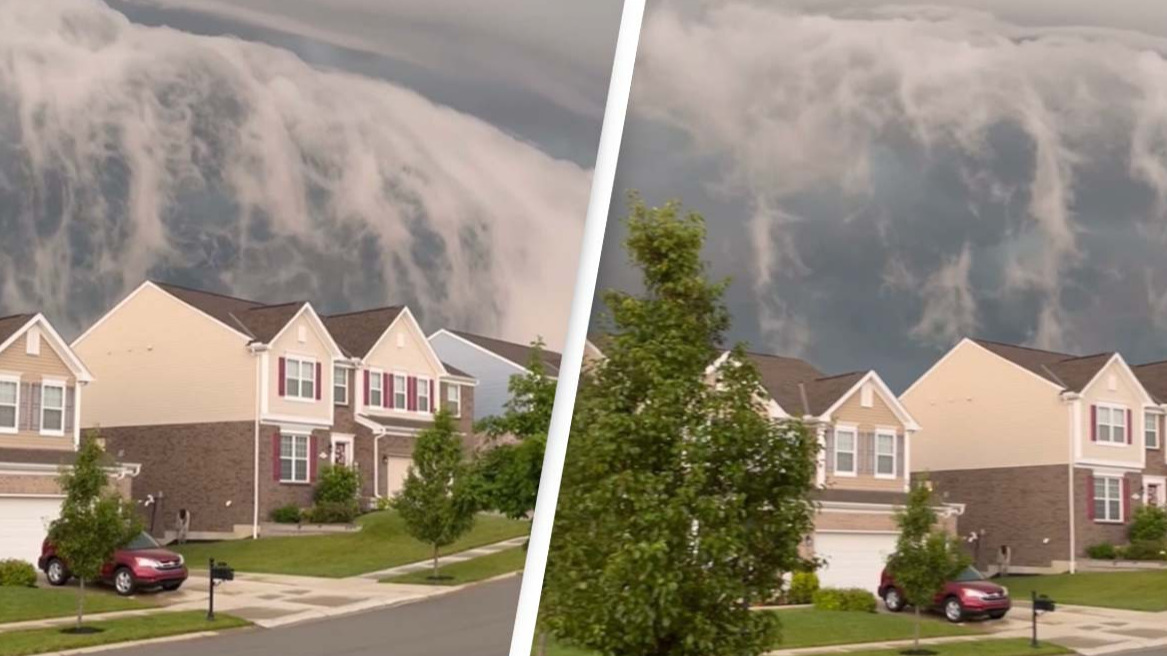


On Sunday, a unique and frightening weather phenomenon known as asperitas clouds appeared in some areas of Ontario, causing many to stop and take notice. These chaotic-looking formations are rarely seen and are believed to be caused by atmospheric turbulence. The eerie and sinister appearance of these clouds has led many to compare them to something out of a horror movie, making them a perfect fit for the spooky season.
Asperitas Clouds: A Rare and Eerie Weather Phenomenon
On Sunday, October 23, 2022, an unusual and captivating weather pattern graced the skies of Ontario, Canada. Asperitas clouds, characterized by their turbulent, undulating appearance, emerged in various regions, leaving onlookers in awe and contemplation.
Background on Asperitas Clouds
Asperitas clouds were officially recognized by the World Meteorological Organization (WMO) in 2017. They are classified as a subtype of undulatus clouds, which exhibit a wave-like appearance. Asperitas clouds are distinct due to their rugged and chaotic formation, often resembling a rough sea or a boiling cauldron.
Their formation is believed to be caused by atmospheric instability and turbulent conditions. These clouds typically occur in the afternoon or evening, when the atmosphere is unstable due to convection and wind shear. As air rises and cools, it forms condensation, creating the distinctive bumpy textures.
Appearance and Impact
Asperitas clouds are known for their sinister and otherworldly appearance. Their chaotic formations and undulating patterns evoke a sense of unease and mystery. The eerie nature of these clouds has led some to compare them to scenes from horror movies.
The presence of asperitas clouds can have both positive and negative impacts. While their beauty can inspire awe and wonder, their ominous appearance can also trigger fear and anxiety in certain individuals.
Top 5 FAQs Related to Asperitas Clouds
1. Are asperitas clouds dangerous? No, asperitas clouds are not inherently dangerous. They consist of water droplets or ice crystals and do not pose any immediate threat.
2. Are asperitas clouds a new phenomenon? Asperitas clouds are not a new occurrence, but their official recognition by the WMO in 2017 has brought them increased attention.
3. Where do asperitas clouds typically form? Asperitas clouds can occur anywhere in the world, but they are most frequently observed in regions with unstable atmospheric conditions, such as the tropics and mid-latitudes.
4. What causes the chaotic appearance of asperitas clouds? The turbulent and uneven appearance of asperitas clouds is caused by opposing wind directions and unstable atmospheric conditions.
5. Can asperitas clouds indicate severe weather? While asperitas clouds are not directly associated with severe weather, they can sometimes precede thunderstorm or hailstone activity. However, they do not always indicate an imminent threat.
Conclusion
Asperitas clouds are a fascinating and uncommon weather phenomenon that leaves a lasting impression on those who witness them. Their dramatic and eerie appearance has sparked curiosity and wonder, making them a topic of ongoing scientific study and artistic inspiration.

In this edition of Health360, a renewed debate over the alleged link between vaccines and autism is sparked by tech mogul Sridhar Vembu's endorsement of a questionable study. Despite reassurances from the medical community backed by data from the WHO, doubts continue to persist, leading to potential harm to public health. The program also delves into the alarming rise in back pain cases in India and explores new treatments.

In an effort to fight the ongoing air pollution crisis, Delhi conducted its first-ever official cloud seeding operation led by IIT Kanpur. The operation involved a small aircraft dispersing specially designed chemical flares into the atmosphere to create rain. While experts say rainfall could occur within 15 minutes to 4 hours, the actual timeframe depends on various factors such as wind direction and moisture content. If successful, the government plans to continue the operation in the coming days.

In the quest for stronger, luscious hair, we often overlook the importance of nurturing the roots. Fortunately, Ayurveda has long stressed the significance of this practice, which has now been backed by modern science. Studies have shown that herbs like Bhringraj and Amla can activate hair follicles, promoting new growth and delaying greying. Fenugreek, Neem, Hibiscus, and Ashwagandha are also found to be beneficial in strengthening and nourishing the scalp, resulting in thicker and healthier hair.

A college student shares her personal journey of becoming a vegetarian, despite facing challenges and health concerns. She then delves into an ethics class she took, where the concept of marginal cases were discussed. Following an article by philosophy professor Alastair Norcross, she concludes that even though individual action may seem insignificant, refusing to consume factory-farmed meat holds moral significance due to the potential to prevent immense suffering for animals.

On October 24, the global community commemorates World Polio Day to honor the legacy of Dr. Jonas Salk and the efforts of countless individuals and organizations in the fight against polio. This highly contagious and potentially deadly disease, once a widespread epidemic, is now largely preventable thanks to the development of a life-saving vaccine. India's successful eradication of polio serves as a testament to the importance of strong vaccination programs and collaborations in public health initiatives.

As winter arrives in India, so does the hazardous air pollution. Delhi NCR's AQI has already crossed the 400 mark, making it crucial to invest in air purifiers, especially after Diwali. Dyson, Qubo, HomePure, and Philips have launched high-quality air purifiers with advanced features to tackle different types of pollutants and create cleaner indoor air. With prices ranging from Rs 5,000 to Rs 1 lakh, these purifiers are a practical and timely purchase for a healthier living.

In a recent family vlog, Indian celebrity couple Shoaib Ibrahim and Dipika Kakar shared their "natural" hair care routine for their son, using a homemade mask made with rice flour, flax seeds, and coconut oil. However, experts warn that what works for adults may not be suitable for babies, whose sensitive skin and scalp could react to the ingredients. While the ingredients may improve hair texture, they do not necessarily promote hair growth. Instead, a healthy diet and good scalp care are more important in maintaining healthy hair.

A recent consumer study has found multiple brands of soft contact lenses in the U.S. to contain "forever chemicals" that can be harmful to both the body and the environment. The study, conducted by the nonprofit organization Environmental Health Sciences, tested 18 varieties of popular contact lenses and found all of them to contain markers for PFAS. Brands such as Acuvue, Alcon, and CooperVision were among the list of affected products. This news serves as a cautionary lesson on the potential risks of overusing contact lenses.

On the birth anniversary of Dr. APJ Abdul Kalam, the ‘Missile Man’ of India, tributes pour in on social media celebrating his life, vision and impact. A visionary scientist, inspiring leader and true patriot, Dr. Kalam's humility, compassion and constant interaction with students continue to inspire generations. His tireless efforts in defense, science and youth empowerment have strengthened India's path towards self-reliance and his legacy continues to motivate young minds to dream big and work hard for the nation.

Recent studies have found that extreme heat, particularly when combined with high humidity, can have a significant impact on mental health. A study in India showed that when wet bulb temperature exceeded 27°C, the probability of reporting severe depression increased by 0.5%, even when the temperature was slightly lower. This finding is consistent with global reviews that have linked high temperatures to mood disorders, increased hospital admissions for psychiatric conditions, and even elevated suicide risk. The Lancet has also published evidence that rising temperatures worldwide are a growing threat to emotional and cognitive health.